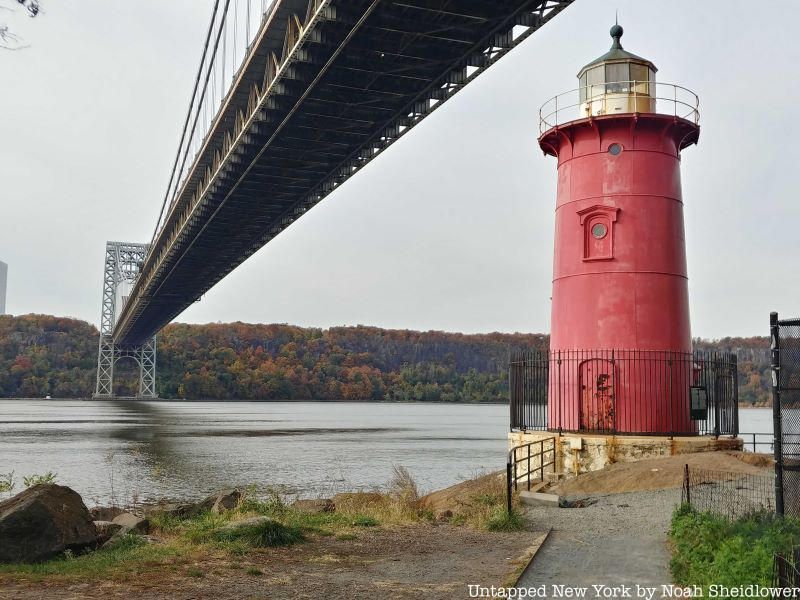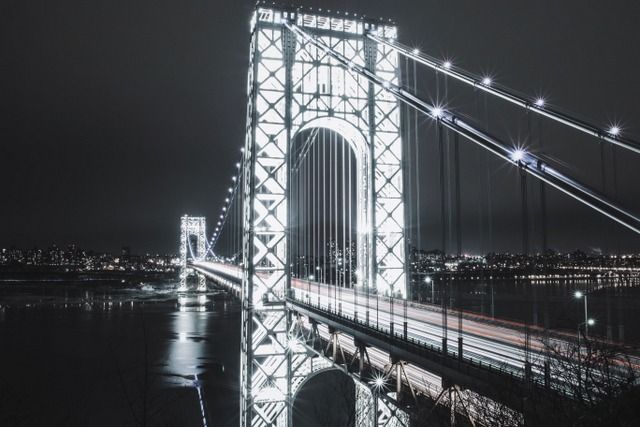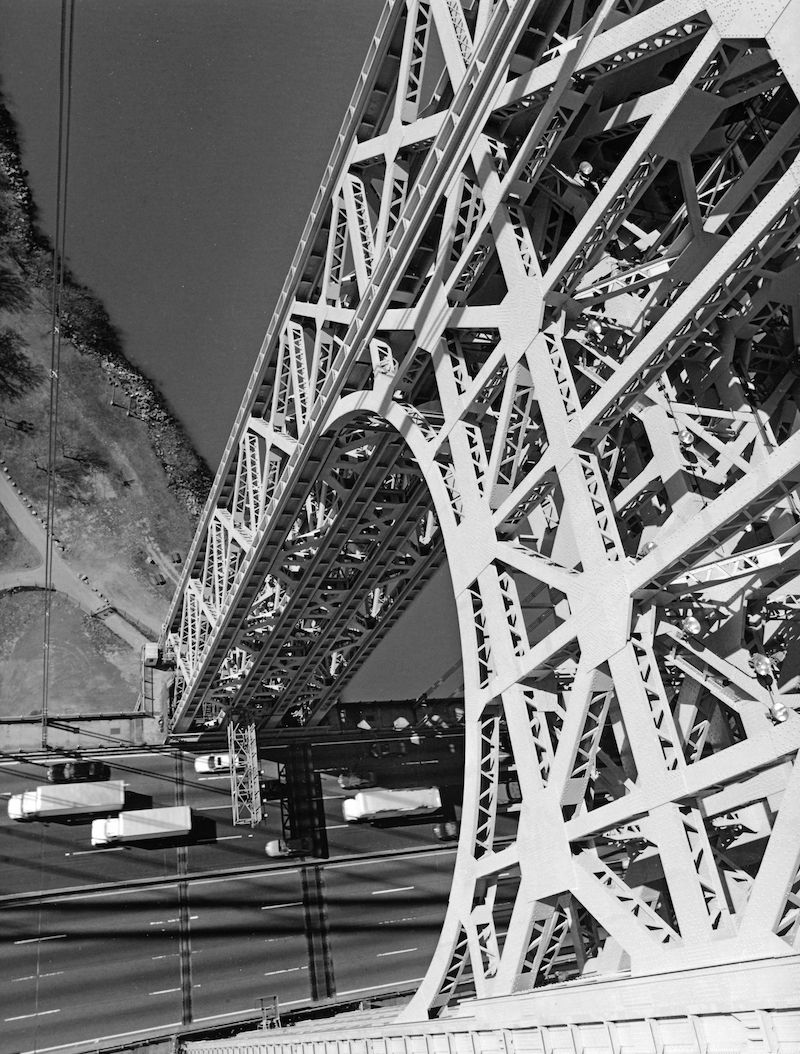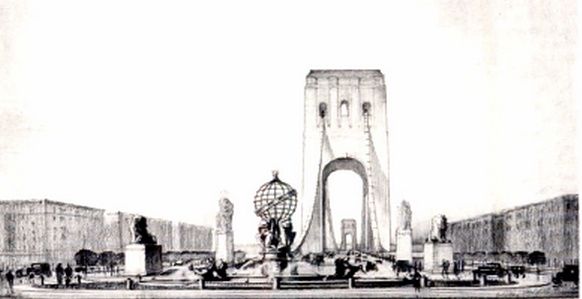How to Make a Subway Map with John Tauranac
Hear from an author and map designer who has been creating maps of the NYC subway, officially and unofficially, for over forty years!



The George Washington Bridge is the busiest roadway in the United States and of all the bridges in New York City, it went up the fastest. From its initial conception down in Midtown to its Beaux-Arts stone facade conceived by Cass Gilbert, no bridge had morphed so dramatically from concept to completion. Read on to learn ten surprising facts about the George Washington Bridge.

Not commonly known about the George Washington Bridge is that it gets lit up, unannounced, for holidays a few times a year. It’s a smaller-scale program like that on the Empire State Building. Back in 2015, the towers were lit for President’s Day and the photographer Dark Cyanide shared with us these shots he took (while almost floating away on the bed of ice).
Brooklyn-born Omero C. Catan holds a unique title in New York City history. He made it his life goal to be the first to test out some of the city’s technological marvels, including the first to ride the Zeppelin, the first to skate on the Rockefeller Center ice rink, and the first to drive through the Lincoln Tunnel. He was also the first to cross the lower level of the George Washington Bridge in 1962.
In a career that began in 1928, Catan has been the first person present at more than 500 historic opening days across the east coast. Read more about Catan here.

Le Corbusier called the George Washington Bridge “the most beautiful bridge in the world,” but its modern allure is a mere accident of time. The bridge’s towers were supposed to be clad in a concrete envelope faced in pink granite chiseled with Beaux Arts flourishes, as well as statuary to cover the points where the barrel cables pass through the roadway on their way to the anchorages. These plans, along with grand plazas for the bridge’s entrances with heroic statuary and a fountain on the New York side, were dreamt up by Cass Gilbert, who most famously designed the Woolworth Building.
According to Le Corbusier, “the towers were to have been faced with stone molded and sculpted in ‘Beaux Arts’ style.… Someone acted… ’Stop! No stone or decoration here.’…They dismissed the architect with his decorations.” In truth, ‘twas the depression that killed Gilbert’s design. Read the full story of what happened here.

Before 9/11, New Jersey-native Dave Frieder was making it his mission to scale the bridges of New York City. With a working partnership with the New York City D.O.T. over the course of eight years, he was given access to a view few of us ever see. His bridge series begins in 1993, but his work in photography goes back to the age of seven, including a stint with the Ansel Adams Gallery, which he got by cold calling. It was through the Ansel Adams circle that he met Othmar Ammann, an engineer on the George Washington Bridge.

In 2013, we met up with Dave Frieder on the upper level of the George Washington Bridge to talk to him about his feats, which were cut short by security concerns after 9/11. He used photography to fully understand the bridges themselves, 16 of which he has scaled and photographed in New York City. He says, “for me, being able to ‘feel the steel’ was a way of understanding how and why bridges work and function.”

The Little Red Lighthouse and the Great Gray Bridge.
This 1942 children’s booktells the true story of the George Washington Bridge’s overshadowing of the Little Red Lighthouse. But the 1880 lighthouse originally stood on the coast at Sandy Hook, New Jersey. In 1921, it was moved to Jeffrey’s Hook in northern Manhattan to aid ships in the navigation of the rocky and narrow portion of the Hudson. The George Washington Bridge was completed in 1931 and its bright lights completely overtook those of the Little Red Lighthouse. A legion of childrenrallied to save it from destruction, and today, the lighthouse has been restored and relit. Today, it’s run by the New York City Department of Parks and Recreation. You can visit and climb to the top of the tower.

As The New Yorker reported in the 1995 article “Writing Down Secrets,” “From 1990 to 1992, Washington Heights had more homicides than any other neighborhood in New York. Partly because of the area’s proximity to the George Washington Bridge, it has an active–and deadly–drug trade.”
The New York Times also wrote, “Partly by accident of geography, Washington Heights became a symbol of the drug crisis in the 1980s. Access to the highways gave parts of the neighborhood almost the feel of a tourist economy. It is at the nexus of the Cross Bronx Expressway, the Harlem River Drive, the Henry Hudson Parkway, and the George Washington Bridge.”

When the George Washington Bridge opened in 1931, there was a pedestrian toll to cross the bridge at $0.10. On the first full day of operation, 20,000 people crossed the bridge by foot while another 10,000 people, discouraged by the fare, watched from Manhattan Plaza.
Three years later, the pedestrian toll was reduced to $0.05 and eliminated in 1940 at the request of Mayor Fiorello LaGuardia and Robert Moses. It’s likely this move was both for the public and for financial reasons: the amount made in pedestrian tolls barely covered the cost of collection.

Measuring 90 feet by 60 feet, the flag that is flown under the arch of the George Washington Bridge on major holidays is considered the largest free-flying American flag in the world. It has been raised on major holidays and is reported to weigh 450 pounds.

Those who know New York City well are aware that there was a real craze for rooftop observation decks — from the Chrysler Building to the Empire State Building to Rockefeller Center. For the design of the George Washington Bridge, architect Cass Gilbert left engineer Othmar Ammann mostly to his own devices, but Gilbert did urge him to include elevators to the tops of the towers in order to utilize them as observation decks. In one set of drawings, Gilbert placed a restaurant with a boat drop-off in the New York tower.

Besides the 55,523 vehicles and 33,540 pedestrians that crossed the bridge, a man from W 73rd Street named Martin Solomon crossed with his horse, named Rubio. He paid the 25-cent toll for himself and his horse. On the 50th anniversary of the George Washington Bridge in 1980, Soloman said, “The bridge holds very fond memories for me, for I was a young man then. Give me a horse and I’ll try it again.”

Secrets of the George Washington Bridge
Next, read about the Top 10 Secrets of the Lincoln Tunnel. Get in touch with the author @untappedmich. This article was also written by Benjamin Waldman and Jinwoo Chong.
Subscribe to our newsletter